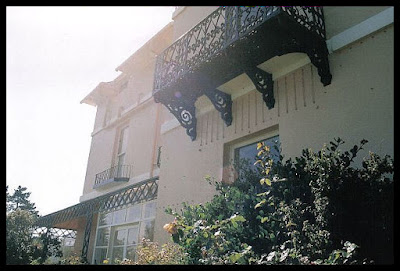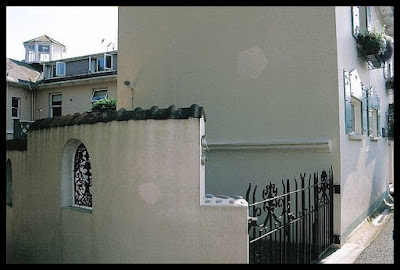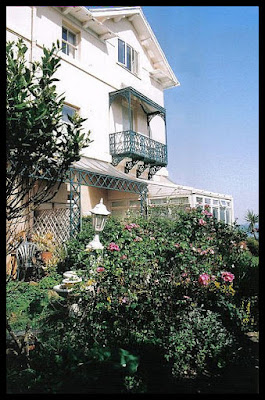Seaforth Lodge is a short distance along from Check House and was built in 1864-65 by Henry Clutton for the Dowager Lady Louisa Ashburton. Like Sir Walter Trevelyan and his wife Pauline of Check House, Lady Ashburton also entertained noted visitors of the day, including Thomas Carlisle and his wife who came to stay with her for a month.
Now separated into different apartments and used for permanent residential purposes and holiday flats, it's still a delightful building. The main building, complete with an observatory on the roof, overlooks the cliffs.
I don't have much information about the building itself, as it isn't a listed building. It is mentioned in the Heritage Gateway though, as being one of a scattering of several significant buildings outside the conservation area, that it's stuccoed with shallow pedimented gables, bracketed eaves and a good balcony and veranda.
This lovely balcony is one of the early examples of wrought ironwork and is really fabulous. There are also other balconies so I'm not sure which one is meant in particular, unless the meaning of 'a good balcony' is collectively. Part of the wrap-around veranda can also just about be seen in the next two photos. More about that later.
On the road at the front is a two-cottage building facing the road comprising Seaforth Cottage and Little Seaforth.
Looking somewhat Bavarian with their style of window shutters, they are rather attractive, although that makes them look quite different to the usual cottages.
There's another balcony on the rear of Seaforth Cottage. I don't have any information about the cottages so I can't say with certainty if it's original or not. I'm pretty sure the wall to the side of the cottage isn't original, as part of its garden/courtyard, seen below. I vaguely remember that it was a shorter wall, which has been altered in height with the addition of modern wrought iron openings, but please don't quote me on this in case my memory's failed me, lol.
Something else I did come across are several news items from different times in the British Newspaper Archive, which was fascinating. For instance, after Lady Ashburton died on the 2nd February 1903 her estate was inherited by the Marquis of Northampton. He either sold it shortly thereafter, or leased it out, because it became a seaside school for girls preparing for Preliminary Junior and Senior Cambridge, also for Advanced Examination in Music (London R.A.M.).
Other news items, later on in the same year 1903, were titled The Seaton Affair and Seaton Sensation, in which the attempted murder of the incumbent 74 year old housekeeper was reported. Miss Eliza Manning was attacked, badly beaten and sustained burns to her hands and face, by John Hawker from the village of Beer who was also employed at Seaforth Lodge as the gardener.
A year before in 1902 Lady Ashburton was summoned under the by-laws to the magistrates for aiding and abetting her horse and carriage driver, James Beazley, to drive along West Walk, which is a pedestrian walkway along the western end of the sea front.
Other news pieces are about the auction of her furnishings and other wordly goods after her death and various events held at Seaforth by the school and a later resident. It's really interesting to see the history of a place through newspaper articles.
And now back to the veranda, which can be seen in these photos taken from the other side. It looks such a lovely place to live with individual gardens for these ground floor flats. Another balcony can be seen here too. And below, another view a bit further along the road...from someone else's driveway! ;)
I really enjoyed researching and writing this. There was a lot more to write about than I first thought when I began. Anyway, something good about leaving it until now is the availability of archived newspapers, which I'll be sure to use again. And speaking of which, that's given me the idea of writing a post about useful resources, so that's one to add when I can. :)




















































































